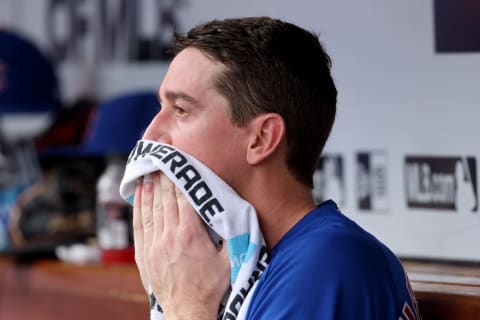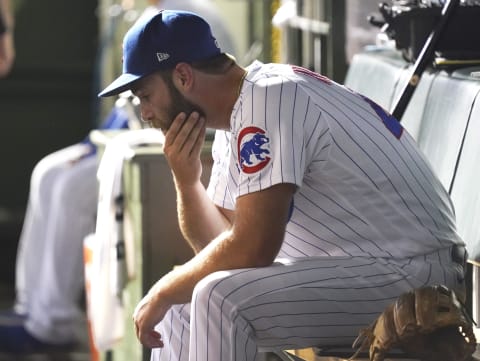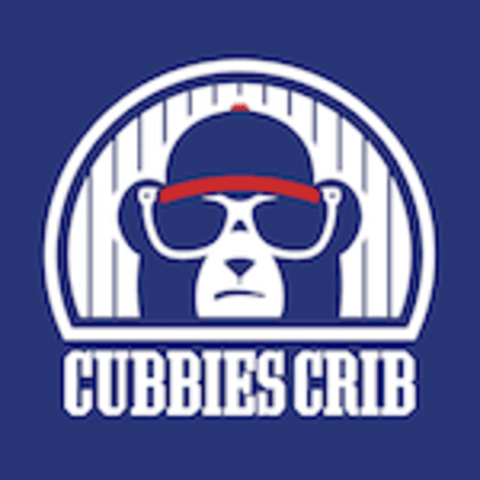Why are the groundball-heavy Cubs pitchers giving up the long ball?

As Paul Newman said in The Magnificent Seven, “it seemed like a good idea at the time.” The Chicago Cubs brought in a number of groundball pitchers to go along with one of the best, Kyle Hendricks, and invited them to serve up worm-burners to a smothering infield defense.
Instead, the Cubs have surrendered 95 homers, tied for the most in the majors. Their groundball rate entering Tuesday’s loss to the Pirates was … OK – at 43.6 percent it’s 17th in the majors, just a hair better than the MLB average. But that isn’t probably where Jed Hoyer and David Ross wanted to see it. So what went wrong?
Cubs: Injuries have ravaged the rotation so far in 2022
Three-fifths of the Cubs notional starting rotation is on the injured list, and Kyle Hendricks has turned into a flyball machine (more on him in a minute). Only Justin Steele, who went into spring training competing for the fifth slot, has been both durable and effective.
New acquisitions Wade Miley and Drew Smyly have impressed when they’ve been able to take the mound. Miley’s performances have gone to plan: he’s kept the ball on the ground and in the yard. Smyly has struggled with the home run so far, but he’s turned himself into a heavy groundball pitcher by refining his excellent curve. Assuming he comes back healthy, there’s reason to believe his gopher totals will come down.
Marcus Stroman was uncharacteristically flyball happy before he went on the IL with a shoulder issue. If that can be remedied, perhaps he’ll return to the high gravity outcomes typical of his career.

Cubs: Kyle Hendricks can’t keep it down and has become a liability
Hendricks is perhaps the biggest puzzle. A pitcher who has made his living keeping baseballs on the ground has achieved just a 37 percent grounder rate this year, along with a 4.5 percent homer rate, both career-worsts. Hendricks has the second-highest ERA among qualified starters (5.43), trailing only only German Marquez of the Rockies (6.16).
Hitters have started elevating Hendricks’ once effective sinker. A pitch that generated 50 percent grounders last season is down to 40 percent this season. Perhaps in response, Hendricks has been replacing some of his sinkers with four-seamers, but that’s always been a flyball pitch for Hendricks, and it is by far his least effective pitch this year, with an xwOBA of .485.
The fastball tinkering is probably more about helping Hendricks set up his curve and changeup. The changeup has been good, but he’s gotten very poor results from the curve this year, although some of that appears be bad luck – the xwOBA for the pitch is a pedestrian .327. Clearly Hendricks and the Cubs are working to address his issues, but for now the veteran right-hander remains a significant home run generator.

Cubs: The overexposed bullpen has struggled after early success
Cubs starters have logged 309 innings, second least in the majors and ahead only of the Pirates. The overexposed bullpen has accordingly given up a league-worst 44 dingers. Three pitchers account for over a third of that total: Daniel Norris (7), Mychal Givens (5), and Alec Mills (4). (Frank Schwindel has also given up four, but, hey, this isn’t his day job.)
Norris has always been a homer-prone pitcher; the value he brings is lots of strikeouts. At this stage of his career, however, he’s probably better suited to be a LOOGY, but he can’t serve in that role because rules. His homer rate against lefties this year is four percent, a high number, but he’s held lefties overall to an acceptable .657 OPS. Against righties, his homer rate is a stratospheric eight percent with an OPS against of <gulp> .989.
Baseball may have moved on from Norris, and so, perhaps, will the Cubs. Unlike the beginning of the season, Ross now has a second lefty in the pen he can use, Brandon Hughes, who is off to a very solid start (2.87 ERA, 3.38 FIP) in his first 13 innings. Norris still generates a fantastic number of whiffs and his fastball has a good spin rate, so there is some hope he can find himself, but his opportunities may shrink.
As for Givens, the Devil came to collect in 2019. From 2015-18, his first four seasons, he had a homer rate of just two percent. Since then, it’s been a bloated 4.4 percent, exactly what he’s put up this season with the Cubs. Like Norris, Givens misses a lot of bats, but the Cubs haven’t been able to correct his gopheritis. Givens got off to a good start, but Scott Effross has recently put up excellent numbers and has a Statcast page that’s red all over. He may have shouldered past Givens into Ross’ Circle of Trust.
The Cubs’ best hope for Mills and some of the other homer-prone bullpen arms is that the team doesn’t have to rely on them as much in the future. This is less a roster construction problem than a rotation problem. The rotation needs to get healthy and perform better to keep the secondary bullpen pitchers out of harm’s way.
Can the Cubs get the pitching staff down to Earth?
A healthy rotation, a renewed Hendricks, a refined bullpen mix … you don’t have to squint too hard to see the route to a less gopher-riffic staff. The prize, sadly, won’t be a playoff spot: the Cubs have already lost just 13 fewer games than the San Francisco Giants lost in the entire 2021 season, and hockey’s not even done yet. The front office’s goals now are longer term: see which of the younger pitchers can become key cogs in the next playoff machine, and see which of the older ones can either last that long or get flipped for mineable ore.

Want your voice heard? Join the Cubbies Crib team!
Next. Rizzo elevating with great success for the Yankees. dark
Relegation doesn’t exist (yet) in professional baseball, but as teams slide toward playoff oblivion, watching major league games becomes more like watching minor league ones. It’s less about the wins and losses and more about watching who develops and how. The Cubs’ great test this season isn’t whether they can win 68 games or 75, but rather whether they can learn more about maximizing the talent they have.